Small Group Experiential Travel
Tour Code
GS9
Start
Doha (DIA)
End
Riyadh (RUH)
Tour type
Cultural
Max Group Size
18
When To Go
Jan, Nov
Activity Level
2 - Moderate
Overnight in
Manama, Kuwait City, Muscat, Salalah, Nizwa, Sur, Khasab, Doha, Dubai, Abu Dhabi, Al Ula, Jeddah, Al Ain, Wahiba Sands, Riyadh, Tabuk, Medina
- Overview
- Info & Inclusions
- Itinerary
- Map & Hotels
- Photos
- Dates & Prices
Highlights
- Explore ancient treasures in the Arab Gulf
- Discover Oman's stunning natural beauty
- Marvel at Abu Dhabi's grandeur and Dubai's soaring heights in the UAE
- Uncover 5,000-year-old forts and burial mounds in Qatar and Bahrain
- Experience Saudi Arabia's unique, off-the-beaten-track adventure
Description
The Arab Gulf States have a rich history of nomadic cultures, leaving behind treasures like ancient tools, carved boats, and royal jewels. On our tour, we'll explore museums, scenic Oman, and the UAE's cities, including Abu Dhabi's grand mosque and Dubai's gold souks. We'll also discover Qatar and Bahrain's blend of modern and ancient, with 5,000-year-old trade routes, fortresses, and burial mounds. Finally, we'll venture into Saudi Arabia, a previously inaccessible land, now open to visitors with a simplified entry process, offering a unique "off the beaten track" experience.
Price Includes
- Full-time Tour Leader services plus local guides at numerous locations.
- Breakfast daily, most dinners (as per tour itinerary)
- All transport (including local flights), accommodation, sightseeing and entrance fees for sites noted as 'visited' in the detailed itinerary.
- Gratuities for drivers, restaurant staff, porters, local guides.
- Airport transfers for land & air customers and for early arriving/late departing land & air customers who book BOTH their extra hotel nights through us.
Exclusions
- International airfare to/from the tour.
- Tour Leader gratuities, most lunches, some dinners (refer to itinerary) drinks, personal items (phone, laundry, etc), international (if applicable) and domestic air taxes, and any excursions referenced as 'optional'.
- Airport transfers for Land Only customers.
- Optional trip cancellation insurance.
- Our post-reservation trip notes offer further guidance on not included meals, visas/entry fees, and locally-paid departure taxes.
Trip Info
- Seasonality and Weather:
The Arab Gulf States generally have a hot desert climate, characterized by very little rainfall and high temperatures throughout the year.
In January, visitors can expect mild winter weather, with average temperatures ranging from 15C (59F) to 25C (77F) during the day. Nights can be cool, especially in the desert regions, with temperatures sometimes dropping to around 5C (41F).
Visiting the Arab Gulf States and Saudi Arabia in January is like experiencing a pleasant winter wonderland, without the snow. The mild weather makes it an ideal time to explore the region's outdoor attractions, such as historic forts, mosques, and traditional souks.
In early November, the weather is usually warm, with average daytime temperatures ranging from 25C (77F) to 30C (86F). Nights are still pleasant, with temperatures around 15C (59F) to 20C (68F).
Visiting the Arab Gulf States and Saudi Arabia in early November is like experiencing a warm and sunny autumn. The weather is ideal for outdoor activities, such as exploring historic sites, taking a traditional dhow cruise, or simply enjoying the local cuisine and hospitality. - Transport and Travel Conditions:
Ground transport provided by private air-conditioned motor coach, 12-36 seats depending on ultimate group size. The tour is not strenuous though it is busy; you must be steady on your feet and be able to endure some heat and long travel days. We have numerous walking tours and visit several sites that are LARGE with steps and uneven surfaces. You must be independent with your own luggage at airports.
Our difficulty rating level 2 refers to the ambitious nature of the itinerary and the lots of moving around that we do. Some days are long and we may have some early starts. Some mountain roads are also winding and rough and, although we use sturdy 4x4 vehicles for some of these journeys, it can be slow going; those sensitive to motion may be affected.
Customs & Norms: Saudi Arabia has relaxed its restrictions for foreign women visiting the country. Though your dress and overall appearance must be conservative, with shoulders, arms and legs covered (the same for men), foreign women no longer need to wear the 'abaya' -- the loose robe-like over-garment. They have also lifted restrictions on women arriving alone (ie without a husband or family member), and on unmarried women and men sharing a hotel room.
Entry / VISA requirements for one or more of the countries visited require that your passport not show any evidence of a prior visit to Israel.
Am I suitable for this tour? Please refer to our self-assessment form - Accommodation:
Hotels used on tour are well-located, air-conditioned, 3-4-star properties with en suite bath/toilet. Single rooms are limited and possibly smaller than twins. Porters are generally available (see 'Inclusions').
Please refer to the 'Map & Hotels' tab for more information. - Activity Level: 2
These are particularly busy tours that feature a lot of moving around, sometimes by train and short journeys on local transport. Walking tours of towns and cities are leisurely but you should be prepared to be on your feet for several hours. Some of our cultural trips that occur at high altitude and/or require greater independence with baggage handling (at hotels, airports, train stations) also fall into this category.
To learn more about the Activity levels, please visit our tour styles page. - Staff and Support:
Tour Leader throughout, local drivers, local guides at various locations. - Group Size:
Maximum 18 plus Tour Leader
Download Itinerary
- Day 1:Arrival in DohaToday we arrive in Doha - welcome to Qatar!
Doha is the capital of Qatar. It is a modern and rapidly developing city and, considering the money being poured into construction, Doha looks set to become one of the premier cities in the Gulf within a few years. Back in 1825, the city was founded under the name Al-Bidda. The name "Doha" came from the Arabic "ad-dawa," or "the big tree." The reference might be to a prominent tree that stood at the site where the original fishing village arose, on the eastern coast of the Qatar peninsula. Or it might have been derived from "dohat" -- Arabic for bay or gulf -- referring to the Doha Bay area.
PLEASE NOTE that the meal plan indicated on each day of this itinerary may vary depending on internal logistics (such as local air schedules), which may result in your Tour Leader switching dinner for an included lunch if it makes more sense on that day.
Overnight in Doha.
Included Meal(s): Dinner - Day 2:Qatar: Area TouringRuled by the Al Thani family since the mid-1800s, Qatar transformed itself from a poor British protectorate noted mainly for coalescing into an independent state with significant oil and natural gas revenues. During the late 1980s and early 1990s, the Qatari economy was crippled by a continuous siphoning off of petroleum revenues by the amir, who had ruled the country since 1972. He was overthrown by his son, the current Amir Hamad bin Khalifa Al Thani, in a bloodless coup in 1995. In 2001, Qatar resolved its longstanding border disputes with both Bahrain and Saudi Arabia. Today, oil and natural gas revenues enable Qatar to have one of the highest per capita incomes in the world.
At our first stop this morning we'll learn about and experience a living tradition with a visit to a camel race track. Here, camels, the ‘ships of the desert,’ are not merely animals; they are symbols of Qatari pride and heritage. We'll witness firsthand their rigorous morning training routines and the intriguing use of robot jockeys, a revolutionary innovation that has redefined camel racing since 2004. Though it is unlikely that we'll witness an actual race, it’s a fascinating immersion into the heart of Qatari culture.
Our day's program also includes the Modern Art Museum as well as the Qatar National Museum. Our will also feature a panoramic tour of Shahaniya Cultural City and the dhow harbour and sea-front corniche area, where will take a stroll; you will be struck by the ever-expanding and rising urban skyline.
Overnight in Doha.
Included Meal(s): Breakfast and Dinner - Day 3:Doha, Qatar - Kuwait City, KuwaitToday we fly to Kuwait City. Flight time permitting, we may begin our sightseeing upon arrival.
The economic, cultural, and political capital of Kuwait, Kuwait City sits on the shores of the Persian Gulf, and is a mixture of exclusive Western-style hotels, designer shopping malls, traditional Islamic architecture, and street markets. Oil revenues have helped Kuwait City rebound from the Gulf War and the building boom shows no signs of slowing down.
Overnight in Kuwait City.
Included Meal(s): Breakfast and Dinner - Day 4:Kuwait City: City TourToday we have a guided tour of Kuwait City.
We will begin with one of Kuwait's most famous landmarks, the Kuwait Towers, an iconic landmark on Kuwait's skyline.
We also visit the Tareq Rajab Museum, a private collection of the Rajab family. The museum deals with calligraphy, pottery, metalwork, glass, wood, ivory and jade carvings of the Islamic world. Early calligraphy is presented in a separate small room, showing pages from the Holy Qur'an, dating back to the first three centuries of the Islamic period. There are also displays of costumes, textiles, embroideries and jewelry of the Islamic world.
We also visit the Bayt Al Othman Museum, with a vast display of popular Kuwaiti culture and history in a large traditional complex of inter-connected ancient houses and courtyards.
We will also have a chance to photograph and admire the very photogenic dhow harbour and fish market.
Overnight in Kuwait City.
Included Meal(s): Breakfast and Dinner - Day 5:Kuwait City, Kuwait - Manama, BahrainToday we fly from Kuwait to Bahrain and transfer to our hotel.
Frequently called the Pearl of the Arabian Gulf, Bahrain is an archipelago of 33 low-lying islands located in the heart of the Gulf, and offering a blend of ancient and modern. This is a place where modern skyscrapers share the landscape with majestic mosques, embodiments of Islamic art, culture and architecture. Rich in history, Bahrain was once part of the ancient civilization of Dilmun and served as an important link in trade routes between Sumeria and the Indus Valley as long as 5,000 years ago.
Manama is Bahrain's modern capital, and is dominated by a Manhattan-style skyline. Today much land, including the diplomatic area, has been reclaimed from the sea.
Overnight in Manama.
Included Meal(s): Breakfast and Dinner - Day 6:Bahrain: Area TourToday will be spent exploring this tiny island state. We begin with a visit to the Bahrain National Museum where we will trace the archaeological development of the region. Through sculpture and ceramics, reconstructed burial mounds, Arabic calligraphy and illuminated Korans, the different periods of Bahrain's history are presented.
We will also visit the Bahrain Fort. The first dwellings on the site are believed to have been constructed around 2800 BC, and have subsequently been overlaid by numerous fortified settlements. The last was built in the early 16th century to defend Portugal's recent acquisition of the islands; for this reason, it is also known locally as the Portuguese Fort.
We will also pay a visit to the Al Fatih Grand Mosque, Bahrain's largest mosque and a magnificent piece of architecture. On the Island of Muharraq we visit Shaikh Isa House, in the old town of Muharraq. This was once the home of the Amir's great-grandfather, Shaikh Isa Bin Ali Al Khalifa. It provides a fine example of local architecture, complete with wall carving and latticework, and representative of traditional 19th century life. The house is complete with a 'wind tower'; constructed 5-6m (16-20ft) above the house and open on all four sides. One of the early forms of air conditioning, this acts as a funnel, catching the breeze and drawing it down into the cavities below, as well as allowing the release of hot air like a chimney.
No visit to Bahrain would be complete without a tour of the Old Souk, with its profusion of colours, sounds, and aromas. The souk lies in the centre of the old town, near the archway of Bab al-Bahrain and, although much of the surrounding area is modern, the street layout and division of occupations still follow traditional lines. All wares are sold, from cloth of different colours and textures to gold and jewely as well as the traditional array of spices and local produce.
Time permitting, in order to sample some of Bahrain's past, we will make a visit to the A'ali Burial Mounds.
Overnight in Manama.
Included Meal(s): Breakfast and Dinner - Day 7:Manama, Bahrain - Abu Dhabi, UAEIn order to sample some of Bahrain's past, we will make a visit to the A'ali Burial Mounds. This is the site of what may be the largest prehistoric cemetery in the world, with approximately 170,000 burial mounds dating from between 3000 BC and AD 600.
We will also visit the pottery makers at A'ali village. This time-honoured industry has been handed down from generation to generation. The clay used for pottery, which is the centre of the industry in Bahrain today, is made from a blend of two types of clay. These are combined to create the optimum blend for their products, which range from traditional bread ovens to water pipes, plant pots, and moneyboxes. Kilns are frequently located inside the surrounding burial mounds, and the smoke given off can sometimes be seen from a distance as you approach the village.
We will also visit Jasra House, built by Sheik Hamad in 1907 and the birthplace of the present Amir in 1933. We will drive out along the Bahrain -- Saudi Causeway, the symbolic and actual link between Bahrain and Saudi Arabia.
This evening we fly to Abu Dhabi, largest of the Emirates and its ultra-modern capital on the Arabian Gulf.
Overnight in Abu Dhabi.
Included Meal(s): Breakfast and Dinner - Day 8:Abu Dhabi: City Touring - Al-AinThis morning we do some touring in and around Abu Dhabi.
Although the city was founded in the late 18th century, the city exploded with oil wealth in the 1960s and the city was entirely rebuilt. There are almost no buildings in the city more than 30 years old. However, Abu Dhabi's citizens are very proud of their fabulously rich city with its broad avenues and futuristic buildings. The city's architecture is an intriguing interpretation of Islamic designs crafted in modern materials.
We will see the magnificent waterfront corniche and visit the Sheikh Zayed Grand Mosque, Abu Dhabi's most iconic landmark, which features eighty-two white domes. Built between 1996 and 2007, it was designed to be an architectural wonder that incorporated both modern and classic Islamic artistic styles. Greek and Italian white marble covers the exterior, while Islamic calligraphy decorates the inside.
We'll also visit the new Louvre Abu Dhabi, which is the result of an unprecedented initiative that laid the groundwork for a new type of cultural collaboration of unparalleled scope between two countries. The museum brings the Louvre name to Abu Dhabi and presents both ancient and contemporary works of historic, cultural, and sociological interest from around the world.
Later we continue to Al-Ain, the "Garden City." We cross the desert to this attractive and relaxed city, cradled by the jagged Hajar Mountains on the Omani border.
Overnight in Al-Ain.
Included Meal(s): Breakfast and Dinner - Day 9:Al-Ain: City Tour - DubaiAl-Ain is the birthplace of Sheikh Zayed bin Sultan Al Nahyan, the first president of the United Arab Emirates, and it has the country's highest number of Emirati nationals. Al-Ain has been inhabited for over 4,000 years; these early cultures built "beehive" tombs for their dead and engaged in hunting and gathering in the area. The oasis provided water for early farms until the modern age. Today Al-Ain is a popular vacation destination, away from the humidty of the coast, and enjoyed by the Emirati and expatriates looking for a break from the hubub of Dubai.
Today in Al-Ain, we discover its history and see its Bronze Age relics, picture-postcard Al Jahili Fort, former royal palace, two museums, and "falaj" irrigation channels. A tour inside the Al Ain Palace Museum, once the residence of the late ruler Sheikh Zayed Bin Sultan Al Nahyan, reveals an insight into their family and lifestyle. We continue to Dubai.
Overnight in Dubai.
Included Meal(s): Breakfast and Dinner - Day 10:Dubai: City TourToday we tour Dubai to observe the city's layout, modern architecture, and lively street-level atmosphere. Known as the city of superlatives, Dubai has transformed its skyline with creative and inspired architecture. Home to some of the most amazing futuristic mega projects in the world, Dubai has the world's tallest building, the tallest hotel, the largest shopping mall, the iconic Palm and World Islands, and also features a ski resort in the middle of the desert!
We’ll pay a visit to the heritage area of Bastakiya (Al Fahidi Historical Neighbourhood), which dates back to the 1890s. The town was primarily built by the affluent Persian merchants drawn to Dubai by the rich trade opportunities and incentives offered by the Emirati government. It was spared demolition in the 1990’s and is now one of Dubai's finest gems in terms of preserving culture and tradition. A visit to this district is a step back in time to the days before electricity and air-conditioning, where wind towers cooled traditional courtyard houses. Many of the old wind tower houses were built by the wealthy merchants of the past, and Old Dubai was famous for these towers lining the Creek on both sides.
A ride on the traditional “abra” boat across scenic Dubai Creek takes us to the Spice and Gold Souks, a great place to explore and enjoy the tantalizing scents and shimmering jewelry in the shop windows. The abra is a wonderful vantage point from which to see the modern and old buildings sitting along the Creekside.
We’ll make a photo stop next to Jumeirah Mosque, an architectural landmark, and then visit Dubai Marina, an awe-inspiring city-within-a city with a cosmopolitan, free-spirited atmosphere and unique lifestyle. A drive across Palm Jumeirah, the world’s largest artificially-made island abundant with opulent hotels and homes, culminates with a photo stop at the iconic Atlantis Hotel. We’ll have a stroll across Souk Madinat Jumeirahm, with its meandering paths and a bazaar-like atmosphere with street cafes and boutique restaurants.
We’ll drive to Burj Al Arab, the iconic hotel that has established unmatched standards of luxury. Built in the shape of a billowing Arabian dhow sail and dominating the Dubai coastline, is one of the world's most spectacular and incomparably luxurious hotels (entry to no-residents is not permitted, but we will view this building from the outside).
Today we include lunch (instead of dinner), where we enjoy traditional Emirati cuisine and conversation in an interactive cultural experience hosted by the Sheikh Mohammed Centre for Cultural Understanding located in one of Dubai’s oldest communities, Al Fahidi Historical Neighbourhood. We will taste new food and learn about the Emirati culture and traditions through a shared experience.
One of the highlights of our day will be a journey to the “At the Top” observation deck on level 124 of the tallest building in the world – Burj Khalifa, the world's tallest building with stupendous views.
Overnight in Dubai.
Included Meal(s): Breakfast and Lunch - Day 11:Dubai - Sharjah - Ras Al-Khaimah - Ajman, UAE - Khasab, OmanFrom Dubai we travel north by road to the third largest of the emirates, Sharjah. Spread out along the Khalid Lagoon, Sharjah is an old trading centre with a laid-back feel.
We'll visit the Sharjah Museum of Islamic Civilization before passing through Ajman, the UAE's smallest emirate, which boasts one of the most attractive waterfronts in the country with soft white sand and lofty date palms. A stroll in Souk Al Arsa, one of the oldest souks in the UAE, will take you on a journey back into the way people lived, prayed, studied and made a living
200 years ago. Still in Sharjah, we'll have a photo stop in front of the largest mosque in the emirate, the King Faisal Mosque. After a visit to Islamic Civilization Museum, we'll travel north into the emirate of Ras Al-Khaimah, the agricultural centre of the UAE, before crossing the border into Oman (have your passports handy!)
From here we travel via a panoramic coastal road overlooking the Gulf of Arabia and the Straits of Hormuz. Our destination is Khasab, local capital of the Governorate of Musandam, the "Norway of Arabia". The Musandam Peninsula is completely separated from the main body of Oman by a stretch of land belonging to the UAE. Musandam has developed distinct language dialects and cultural mores. A huge pale limestone massif with steep strata crossed cliffs descending into the sea, the peninsula has remained isolated from the rest of Arabia and is still very remote. The area is sparsely populated by the Shihuh tribe, who for centuries have been carving a precarious existence from the seas. Some villages can only be accessed by boat.
On arrival we have a city tour, including the restored Portuguese Fort of Khasab, a museum where many Omani handicrafts items are displayed. We will also pass by the prehistoric rock carvings depicting camels, ships and warriors in the neighbouring village of Qadah (we may accomplish this sightseeing tomorrow if time constraints dictate).
Overnight in Khasab.
Included Meal(s): Breakfast and Dinner - Day 12:Musandam Peninsula: Dhow CruiseMountains dominate the Musandam landscape as they rise straight from the sea creating a fjord-like coastline (hence the Norway comparison) that is unique in the region. This coastal zone, along with many offshore islands and inlets, abound with wildlife, including seabirds, dolphins, and whales.
After boarding our traditional Omani dhow pier side, the cruise will take you toward Musandam's longest and most spectacular fjord, which is often referred to as 'Norway of the Arabia'; calm, turquoise waters contrast with the creamy white limestone cliffs. Along the way we will pass small fishing villages and perhaps even encounter dolphins. The dhow will anchor in the vicinity off Telegraph Island, allowing you to take a swim (bring your suit!) or just sit back and enjoy soft drinks, tea or coffee while admiring breathtaking views of mountains rising in the distance to over 2,000 feet. Our cruise continues with lunch provided on board. After the tour leisurely cruise back to Khasab.
Overnight in Khasab.
Included Meal(s): Breakfast, Lunch and Dinner - Day 13:Khasab, Oman: Mountain Safari - Muscat, OmanWe have an early start today, departing by by a 4-wheel drive vehicle (closed and air-conditioned). Driving is partially on winding mountain roads; we will be able to enjoy some of Oman's most stunning sceneries. We board our 4-wheel drive vehicle and get ready for an exciting and breathtaking trip to Jebel Harim (translated as the Mountain of Women). With a height of 6,260 feet it is the highest peak on the Musandam Peninsula. During your journey to Jebel Harim, you will be able to enjoy incredible vistas, including terraced mountain villages, lush Acacia forests and wadis (dry river beds). Following a drive of a little over an hour, a stop will be made at a Bedouin village located at an elevation of 3,000 feet. The village of Sayah, surrounded by palm groves, is one of the most picturesque villages on the Musandam Peninsula. After a stop for photographs and to enjoy this idyllic setting, we continue our drive to Jebel Harim. There will be time to admire the grand panorama from the mountain's summit. The return drive takes us past Khawr Najid, a stunning sea viewpoint overlooking the Indian Ocean. We stop at Al Khalidya Nature Park before concluding our adventure back at Khasab.
We then fly to Muscat, Oman. Oman has a population of only 3 million living in a country of over 300,000 sq km (117,000 sq miles). Most of the people live in or around Muscat, the capital. The cultivation in the Batinah, and hence the villages, is concentrated in a narrow strip along the coast where about half of the cultivated land in all of Oman is located. The palm groves are densely green sheltering limes, bananas, pomegranates, figs, papaya, mangoes, guavas, and vegetables. Fishing is also very important in this area.
Muscat is not actually one town, but rather three separate towns, plus several associated towns all separated by geographical features of the mountainous, indented coast. Time permitting, we may accomplish some of our Muscat sightseeing upon arrival.
Overnight in Muscat.
Included Meal(s): Breakfast and Dinner - Day 14:Muscat: Area TourOman's position on the Arabian Sea/Indian Ocean, and its isolation from the rest of Arabia, have given the country a much more outward orientation; indeed trade with India and Africa has been conducted for thousands of years. During the age of the European empires in India and Africa, Oman developed strong ties to Britain. Sharing the mountainous south coast of the Arabian Peninsula with Yemen, Oman shares many features with its western neighbour, including aspects of their dress and architecture. In ancient times this area was where highly prized Frankincense was grown and exported.
Today our sightseeing includes the Sultan Qaboos Great Mosque. After a lunch break we'll visit the Old Palace Area (from the outside), and the fabulous National Museum.
Overnight in Muscat.
Included Meal(s): Breakfast and Dinner - Day 15:Muscat - Qariyat - SurToday we depart Muscat by road to the Bimmah Sinkhole, a giant depression where sea water has merged with fresh. Two flights of steps take you down to a dazzling pool of blue and green water. After a lunch break at the sinkhole, we continue past Wadi Shab and Wadi Tiwi. This is a region where we can savour the atmosphere of traditional Oman as it was before the days of oil. Towns here prospered centuries ago on the trade with Africa and Zanzibar coming through the Omani port of Sur. Fine houses and forts were built and many of them still stand today, set back from the road behind the modern buildings. Most of the desert area of Oman is a flat gravel plain but the Wahiba has huge ridges of orange sand dunes separated by valleys. The few Bedouin who still live here breed fine camels.
Oman is not principally a land of sand deserts but rather a dramatic area of dry, jagged mountains with narrow river valleys (wadis) between. The evidence of Oman's tribal past is everywhere, with ruined forts commanding every important vantage point. Much of Oman remains hidden in remote valleys and there is a feeling of self-imposed isolation here at the tip of the Arabian Peninsula.
Overnight in Sur.
Included Meal(s): Breakfast and Dinner - Day 16:Sur - Wahiba Desert CampSur's historical importance is based on the building of dhows, the wooden sailing vessels used to sail to India and other countries from Sur. We may visit the dhow building yard if there is any activity to observe (in recent times, the number of dhows being built here is unfortunately very few). Sur was an important port in ancient times, but really came into its own when Oman started to trade extensively with East Africa. Merchants here made fortunes from the trade in slaves and cloves and used the profits to build elaborate houses. We will learn of Sur's history and its role in shipbuilding.
Later we transfer to 4x4 vehicles for our foray into the Omani desert for a desert camp experience. Our camp is located within the breathtaking golden sands of the Oman desert, called the Wahiba Sands. Gas is used for the cooking and refrigeration; paraffin lamps and candles provide light. The camp is a very peaceful place to relax and to experience authentic desert nights.
Our accommodation is in the form of well-equipped huts (called Barasti) with comfortable beds (mattress, blankets, pillows and fresh sheets), and private bath facilities. Our huts are basic but cozy, and a wonderfully atmospheric way to enjoy the desert way of life and to learn about the local culture in a warm and friendly environment. Activities include sunset admiring, musical entertainment, and stargazing.
Overnight at Wahiba Desert Camp.
Included Meal(s): Breakfast and Dinner - Day 17:Wahiba - Ibra - Jabreen Castle - NizwaWe recommend an early wake-up in order to observe the rising sun over the dunes. After breakfast we depart our camp and head toward Nizwa, the main town of the interior province.
En route we experience the inland side of the great mountainous backbone of Oman, where sands lap at the thresholds of farmlands, and a string of border towns marks the zone of transition between nomadic and settled peoples. In the oasis villages of Oman, desert and village economies have mingled for ages to their mutual benefit. Living within and along the sands are approximately 3,000 pastoralist Bedouins belonging to different tribes, who are primarily herders of goats and camels.
Forts and castles are Oman's most striking cultural landmarks and have historically been used as defensive bastions or look-out points. It is estimated that there are over 500 forts, castles and towers in Oman. Today we will visit a few of them that are particularly remarkable in their architecture and style. Included is a stop at Bahla Fort, a UN World Heritage Site.
We continue our drive to Jabreen Castle, built as a defensive stronghold. Jabreen is perhaps the finest of Omani castles, with dungeons, passages, rooms and ceilings decorated with fine carvings and paintings. This castle is distinguished by the inscriptions and frescoes that adorn its rooms; its ceilings are decorated with paintings and Islamic-era style inscriptions, and its doors are beautifully carved. We also explore the village of Misfat Al Abriyeen where we can see its fascinating history, agriculture and falaj watering system.
At some point during our time in Nizwa, we'll visit the Oman Across Ages Museum, a relatively new addition to Nizwa, which offers a captivating journey through Oman's rich history. Opened in March 2023, this state-of-the-art museum utilizes cutting-edge technology to bring the past to life. From prehistoric times to the modern era, visitors can explore a diverse collection of artifacts, including archaeological finds, traditional Omani clothing, and historical documents.
Overnight in Nizwa.
Included Meal(s): Breakfast and Dinner - Day 18:Nizwa: Jebel Shams MountainsToday we venture to the majestic Jebel Shams, often hailed as the "Grand Canyon of Oman." As the highest peak in the Sultanate, it offers breathtaking panoramas and a glimpse into Oman's ancient past. We delve deeper into the Western Hajar Mountains, exploring the charming village of Al Hamra. Here, we'll wander through date plantations, admire the ruins of ancient houses, and soak in the serene mountain scenery.
Our journey continues to Wadi Ghul, a dramatic canyon carved by centuries of erosion. As we ascend the winding road, we'll encounter small villages nestled amidst the towering cliffs. A highlight of our adventure is a hike to the abandoned village of As Sab. Following an ancient donkey path along the edge of Wadi an Nakhar, we'll enjoy panoramic views of the canyon and the distant Al Hamra.
We conclude our day back in Nizwa.
Overnight in Nizwa.
Included Meal(s): Breakfast and Dinner - Day 19:Nizwa - Bilad Sait - Muscat - SalalahToday we continue by 4X4 through breathtaking mountains scenery; terraced farming and beautiful mountain villages line our route, as well as great views especially of Bilad Sait Village. It is in these mountain areas where Omani honey is produced. Beekeeping has been practiced here since ancient times. The specialist bee keepers of northern Oman have developed great skill in obtaining honey and propagating bee colonies in a sustainable manner. Our guide will take us to one of the bee keepers to observe this traditional practice.
Up on reaching the main road, we continue to Muscat along the fertile Batinah coast with its beautiful beaches, forts, fishing villages and places famous for camel racing and bull fighting. This evening we connect with our flight from Muscat to Salalah, the second largest town in Oman. Salalah is isolated far in the south east of the country, close to the Yemeni border. The setting here is magnificent, as Salalah faces the Arabian Sea/Indian Ocean, backed by hills.
Overnight in Salalah.
Included Meal(s): Breakfast and Dinner - Day 20:Salalah AreaThis morning, before heading along the coast and into the mountains in our four-wheel drives, we tour Salalah including the archaeological site of Sunhumran. In pre-Christian times this tiny area was one of the three centres of production for one of the ancient world's most highly prized and expensive commodities, Frankincense. This was the main area in which the Frankincense tree grew. Demand for this rare product was enormous in the Mediterranean region as it was burnt in huge quantities during religious rites in temples throughout the Roman world (Frankincense is a gum dried from the sap of a special tree that only grows in this area). We visit the site of Sumhuram, the port at the beginning of the Incense Route.
We finish at the traditional boat-building village of Taqua, the "Queen of Sheba's Palace." You'll have a chance to shop for Frankincense at the market in Salalah.
Overnight in Salalah.
Included Meal(s): Breakfast and Dinner - Day 21:Salalah, Oman - Jeddah, Saudi ArabiaToday we fly to Jeddah - welcome to Saudi Arabia!
Founded as a Red Sea fishing hamlet over 2,500 years ago, today's Jeddah is the commercial capital of Saudi Arabia. This city first truly came to light in 647 AD when it was turned into a port for Muslim pilgrims making the Hajj to Mecca.
Jeddah has been mentioned in many ancient travellers' journals and texts, some describing it as "the city surrounded by walls with beautiful markets and teeming with buildings," while others described it as "the small city on the Red Sea coast crowded with pilgrims." It seems as though there have always been inns, caravanserais, and hostels catering to travellers and pilgrims.
Overnight in Jeddah.
Included Meal(s): Breakfast and Dinner - Day 22:Jeddah: City TourJeddah -- "Where desert and water meet rises the gateway to Islam, a city of life and a crossroad of culture."
This city has grown from humble origins. In AD 647, Caliph Osman Ibn Affan chose Jeddah as the main port for the city of Mecca (Makkah), and it became known as Bilad al Kanasil -- the City of Consulates. In the 16th century, the Ottomans built a stone wall around the town in order to fortify it against attacks from the Portuguese. Jeddah remained a fortified, walled town for centuries of Ottoman influence and was not released from Turkish rule until 1915. The buildings of old Jeddah were tall and graceful, constructed of coral limestone and decorated with intricately beautiful wooden facades, known as ‘rawasheen.’ These were designed not only to break up the sun's glare, but also to take advantage of the cooling sea breezes when the inner windows were opened. One cannot help but feel that, with the enclosure of the town within high, fortified walls, the sea breezes may not have stood much chance of reaching Jeddah's early inhabitants; hence their penchant for building their houses tall and for sleeping on the roofs on hot summer nights.
Our sightseeing tour today will include a walking tour around old Jeddah (Al-Balad). In bygone days, the streets of Old Jeddah were twisting, unpaved and haphazard, flanked by closely-packed buildings. A thick layer of sand covered these streets, packed solid by numerous tramping feet. Mingling with the strolling inhabitants, water carriers and other street vendors, camel caravans once plodded their way through the wider thoroughfares, while goats and donkeys wandered in the narrow alleys.
We will be sure to visit the bustling Alawi Souq, the heartbeat of Old Jeddah and still an exciting and picturesque part of today's city. Traditionally the open-fronted shops were grouped together according to trade; an old Oriental bazaar tradition, which has continued into modern life. Wares were displayed in the street under palm-leafed canopies, sheltering traders from the relentless sun -- a far cry from the modern-day comforts of air-conditioning in the luxurious shopping malls of today.
We'll also visit an extremely eclectic museum, Al Tayebat International City, which features an almost bizarre collection of every type of historical object in a reconstructed Old Jeddah style building.
In the evening we will drive along the Corniche, a cultural landmark of the city. After the Maghreb (sunset) prayer, the Corniche springs to life, with Saudi families dining al fresco. Picnicking seems to be a favourite local hobby, and is regarded as an ideal opportunity to get together for a family chat and a substantial supper.
Overnight in Jeddah.
Included Meal(s): Breakfast and Dinner - Day 23:Jeddah - Fast Train to MedinaThis morning we will take the high-speed train on the Haramain Railway (+/- one hour). Completed in 2018, it connects the holy cities of Medina and Mecca.
Medina is one of Islam's two most holy cities. The Prophet Muhammad lived and taught in Medina after departing Mecca in the year 622 AD. His arrival in Medina marks the beginning of the Islamic Calendar. Medina, or Medina al Munawwarah, means "the Enlightened City". The key focal point of the city is the Masjid an Nabawi or the "Prophet's Mosque," constructed by Muhammad and also the site in which he is buried.
We hope to be able to get close to the mosque for exterior photos, but due to the cultural sensitivity of a city that, up until very recently, was closed to non-Muslims, we will proceed based on the local guide's first-hand information at the time on whether this would be appropriate.
We'll also visit the old Ottoman Hijaz Railway station that has been converted into a comprehensive museum with artifacts and displays covering many periods in the country's history (please note that several vestiges of the railway are currently under ongoing renovations, which could impact our plans at this an other related sites).
Overnight in Medina.
Included Meal(s): Breakfast and Dinner - Day 24:Medina - Al-UlaOur journey continues to Al-Ula, passing several villages en-route.
This journey west follows along some amazing rock formations and some great desert sites where we may have opportunities to take photos of camel herds wandering in the vast desert. The Al-Ula Oasis was located on the incense route and was the capital of the ancient Lihyanites. Today, Al-Ula is located in the heart of a beautiful corner of Saudi Arabia, on the west side of a narrow palm-lined wadi. Al-Ula has a rare combination of striking geography, ancient history, ethnography and nature that makes this a fascinating place to visit. This is a rare example of an Islamic city, which dates back to the 11th Century AD.
During our time in Al-Ula, we will have a walk through the old town, now being developed by the RCA into a tourist hub filled with cafes and local handicraft stores that feels like a walk back through time. Our adventure will also include a stop at Elephant Rock and the Al-Ula Museum (though it has been periodically closed in recent years).
Overnight in Al-Ula.
Included Meal(s): Breakfast and Dinner - Day 25:Al-Ula & Madain SalehMadain Saleh, which rises up from the sands in a landscape of real beauty, dates back to the Nabataean civilization and is considered to be one of the most important archaeological sites in Saudi Arabia. The Nabataeans were an ancient trading people whose oasis settlements gave the name of Nabatene to the borderland between Syria and Arabia, from the Euphrates to the Red Sea. This "Capital of the Monuments" is home to over 130 tombs, many dated to between the 2nd century BC and the 2nd century AD. Inscriptions engraved on rocks, facades of graves and mountains provide evidence of the existence of civilizations that had prevailed and fallen in this area. The Kingdom of Nabataeans, with its capital Petra in Jordan, expanded to dominate Madain Saleh, their second city. The landscape here of sweeping sand and wonderful rock formations is stunningly beautiful. The tombs are also in an excellent state of preservation, due largely to the fact that the local stone is much harder than that found at Petra.
Our sightseeing of this extraordinary site will include an early morning visit to some of the most important tombs with the local Royal Commission for Al-Ula (RCA) Governate, “Experience Al-Ula.” The RCA has been established to protect the heritage of Al-Ula and sustainably develop the tourism facilities of the region. They have exclusive access to the Hegra site that protects the majority of the tombs in the area.
We will see the famous Qasr al-Farid tomb, a spectacular carved piece of rock standing alone in the desert, as well as the rock construction known as Al-Diwan, likely used for Nabataean ceremonies. We will also view Qasr al-Bint and the Hejaz Railway Station #21. We will also be able to view the magnificent Al-Khuraybah tombs, cut into the face of a cliff.
Overnight in Al-Ula.
Included Meal(s): Breakfast and Dinner - Day 26:Al-Ula - TabukToday we travel to Tabuk.
From snowy mountains to the deep blue sea, the province of Tabuk in Saudi Arabia is home to some of the most varied natural landscapes in the country, offering possibilities for beach holidays, island hopping, Red Sea diving, mountaineering and, of course, sightseeing. The region holds some of the nation’s highly treasured historic and archaeological sites, a rich heritage left behind by ancient civilizations of foregone eras.
Tabuk is situated amid a grove of date palms. In former times it was a station on the Hejaz railway (now defunct). At the edge of the old part of Tabuk stands a Turkish fort, built in 1694. Present-day Tabuk is one of the fastest-growing industrial centres of Saudi Arabia.
Tabuk's early-20th-century Hejaz Railway Station is one of the best-preserved in Saudi Arabia (and one that has not been impacted by renovations at the time that this itinerary went to press). There are 13 recently refurbished buildings spread over 80,000 sq metres and these include a workshop, a handicrafts centre, and a building that houses a locomotive, a freight car and several Ottoman relics worth viewing. The Hejaz Railway was a narrow gauge railway that ran from Damascus to Medina, through the Hejaz region of Arabia, with a branch line to Haifa, on the Mediterranean Sea. It was a part of the Ottoman railways network and was built in order to extend the previously existing line between Istanbul and Damascus all the way to the holy city of Mecca (eventually being able to reach only Medina due to the interruption of the construction works caused by the outbreak of World War I). The main purpose of the Hejaz Railway was to establish a connection between Istanbul, the capital of the Ottoman Empire and the seat of the Islamic Caliphate, and Hejaz in Arabia, the site of the holiest shrines of Islam and the holy city of Mecca.
Dating to 1559, Tabuk Fort is now a museum, with several rooms housing some interesting historical artifacts from the Ottoman period and lots of signage about the history of Tabuk, its connection to the Prophet Muhammad and several famous travellers. The castle features a ground-floor mosque, an open courtyard and a stairway to the castle’s 2nd-floor mosque, and watchtowers. Outside are cisterns that once captured water from a spring that the Prophet Muhammad reportedly drank from.
We'll see the At Tawba Mosque (from outside), where the Prophet Muhammad prayed when he arrived with 30,000 men in AD 630 for the Battle of Tabuk against the Byzantines. The battle never took place but, while here, the Quran's ninth chapter, Surah At Tawba, was revealed. At Tawba Mosque was originally made of bricks, mud and palm-tree trunks. The Ottomans rebuilt it in 1652.
Overnight in Tabuk.
Included Meal(s): Breakfast and Dinner - Day 27:Tabuk - Wadi al-Disah - Fly to RiyadhToday we travel to Wadi Al-Disah, a 15 km long canyon running through Jebel Qaraqir, a sandstone massif lying about 80 kilometers south of the city of Tabuk. This natural wonder was for a long time a well-kept secret among explorers, before the road leading to the nearby city of Disah was built and satellite images were available to the public. Today, there are two roads leading to each entrance of the wadi and this natural wonder has become one of the must-see places in Saudi Arabia.
The first striking feature of this wadi is its dimensions: at the eastern entrance of the canyon the side cliffs are already higher than 100 meters, but at the western entrance the gap between the bottom of the wadi and the tallest cliffs reaches as high as 500 meters! It is there, from the massive rocky peaks standing on both sides of the canyon, that one can admire the most dramatic scenery of this magical place. The second -- and most unexpected -- amazing feature of the wadi is a water stream that runs through the western part of the canyon towards the city of Disah.
Later we fly to Riyadh, situated on a large plateau in the center of the Arabian Peninsula, and both the capital of Saudi Arabia and it's largest city.
The name Riyadh is derived from plural of the Arabic word rawdha, which means "garden," particularly those formed in the desert after the spring rains. Riyadh has for more than 1500 years been a fertile area set in the heartland of the Arabian Peninsula. The settlement was historically famous for its palm trees, dates and orchards. Once a small walled city, Riyadh has developed into a dynamic metropolis over the years and has become a focal point for both travel and trade. One of the richest and splendid cities in this modern era, this is truly the heart of the Arab world.
Overnight in Riyadh.
Included Meal(s): Breakfast and Dinner - Day 28:Riyadh: City TourConsidering that at the turn of the 20th Century there were no main roads leading into Riyadh, this desert capital has come a long way. Although Riyadh has always been the base of the ruling Al-Sauds, it was only in the 1970's that ministries and embassies relocated from the more cosmopolitan city of Jeddah to the traditional capital of Riyadh. Much of Riyadh has been constructed since the boom years of the 1970's.
In addition to being the centre of power, the city is also a commercial hub. Numerous educational, financial, agricultural, cultural, technical, and social organizations have set up base here. The architecture is mostly modern, including contemporary high-rise towers and spacious, air-conditioned malls. The Al-Diriyah district, located to the northwest corner of the modern city, is the original seat of power of the Al Saud family. It has been recently rebuilt in a style meant to evoke the old pre-20th century mud-brick buildings that once existed. Now a focal point for Riyadh tourism, we will take the opportunity to visit the UNESCO-listed site of At-Turaif and explore its winding alleyways.
Our full-day of sightseeing will also include a visit to the Masmak Fortress, a very important historical monument in Riyadh. Located in the centre of the modern city, this fortress and museum symbolizes the unification and foundation of the Kingdom of Saudi Arabia. A highlight of our day will be the state-of-the-art National Museum, of the finest in the Middle East. Encased within modernist architecture, its two floors contain eight well-designed and informative galleries covering Arabian prehistory, history, culture and art. When passing through the new part of city we will view the Al-Faisaliah Tower and visit the Kingdom Tower.
Overnight in Riyadh.
Included Meal(s): Breakfast and Dinner - Day 29:DepartureDeparture from Riyadh.
RHLAH S'IDAH / BON VOYAGE!
Included Meal(s): Breakfast
Regions Visited: Gulf States
Countries Visited: Bahrain, Kuwait, Oman, Qatar, The Kingdom of Saudi Arabia and United Arab Emirates
Countries Visited: Bahrain, Kuwait, Oman, Qatar, The Kingdom of Saudi Arabia and United Arab Emirates
*The red tour trail on the map does not represent the actual travel path.
The following is a list of sample hotels at some locations included on this tour. The hotels shown here are meant to provide a general sense of the standard of hotel we usually aim for; they are not necessarily confirmed for your chosen departure.
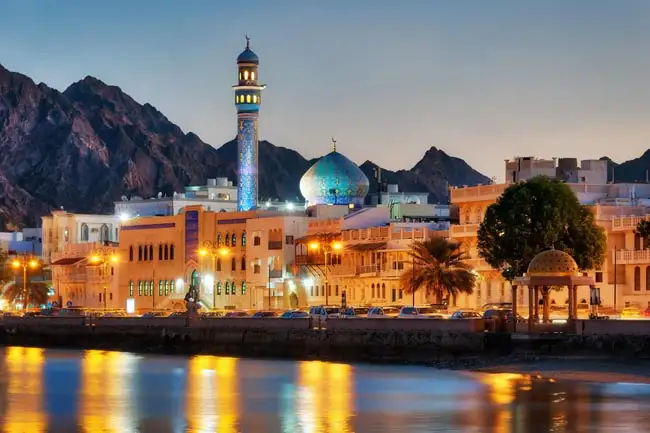
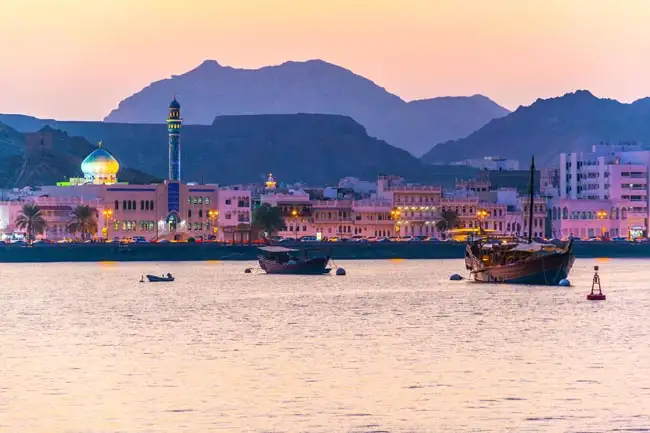
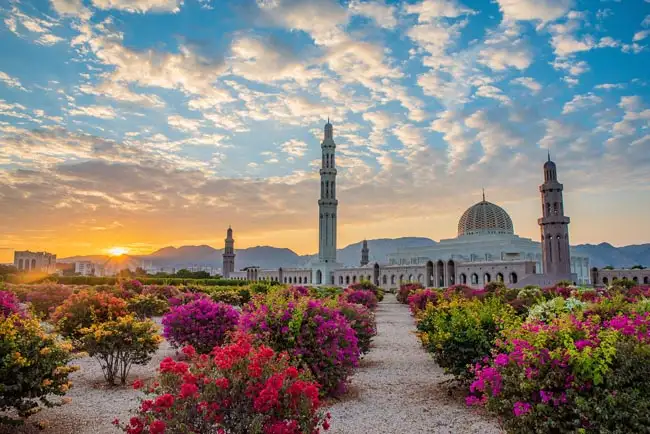
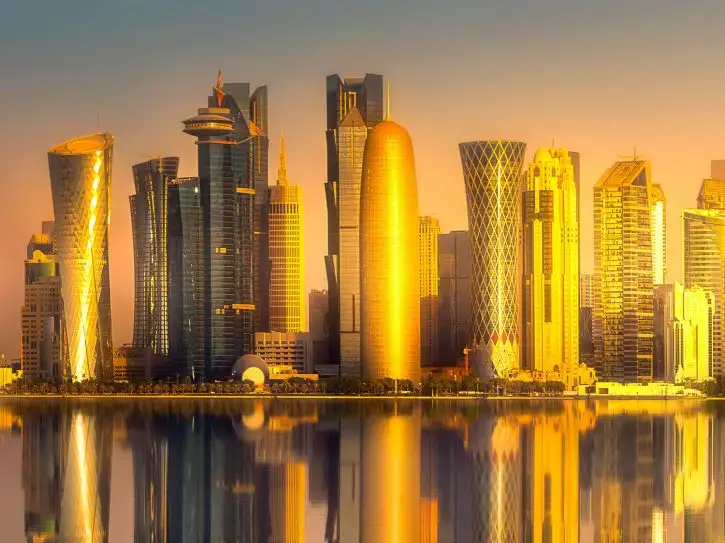
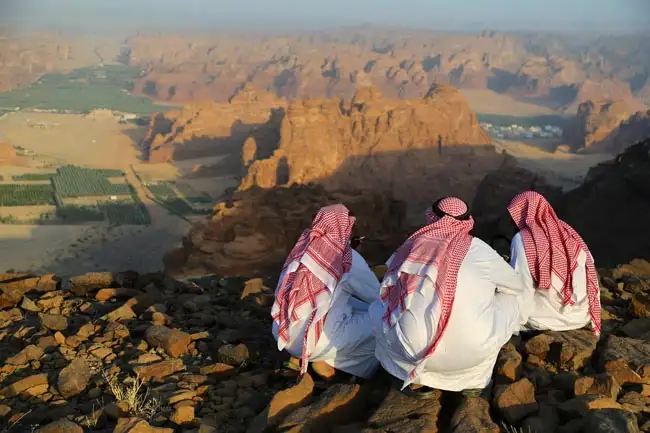
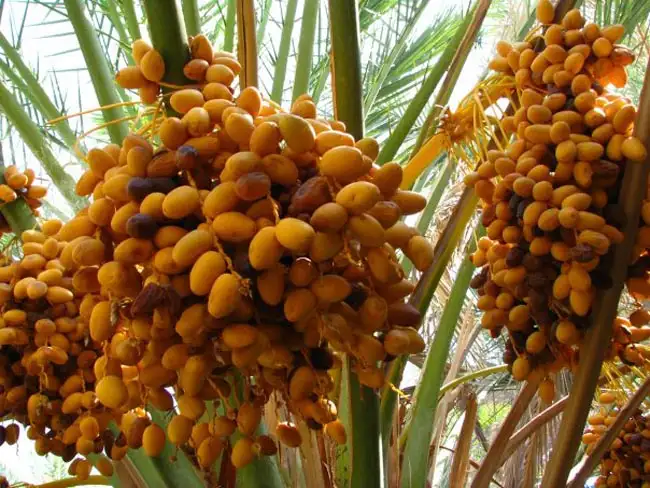
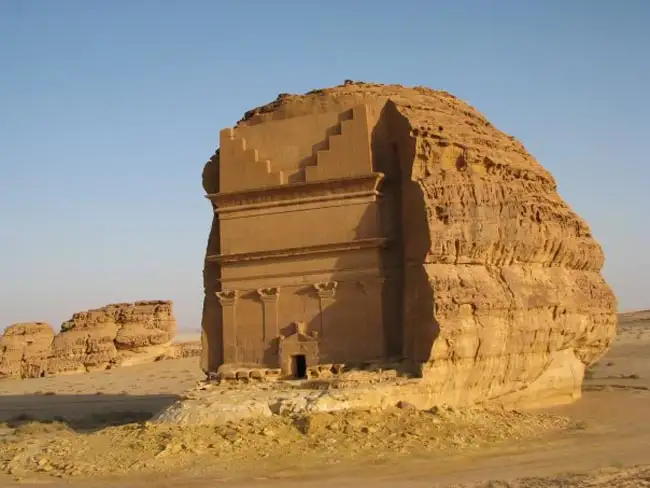
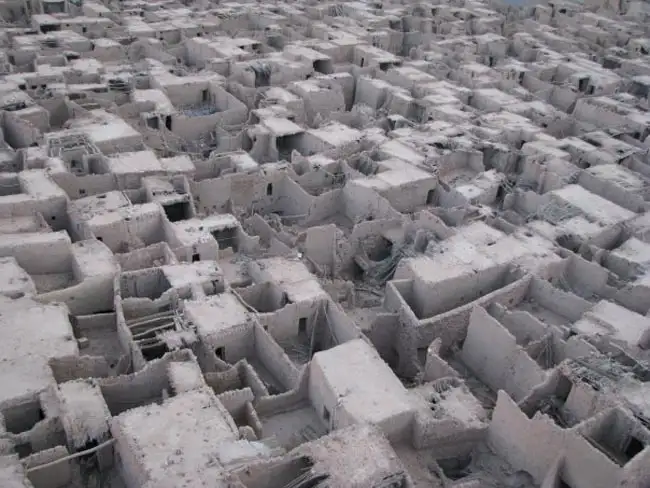
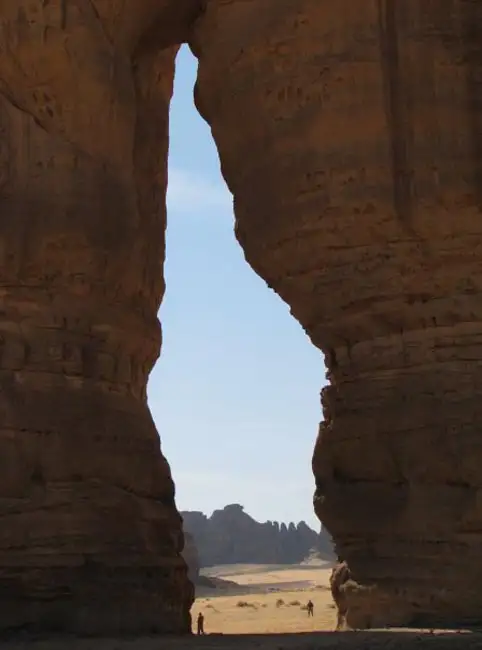
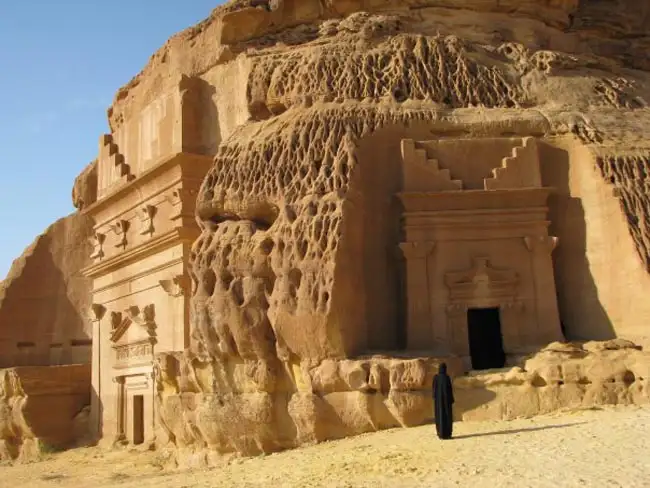
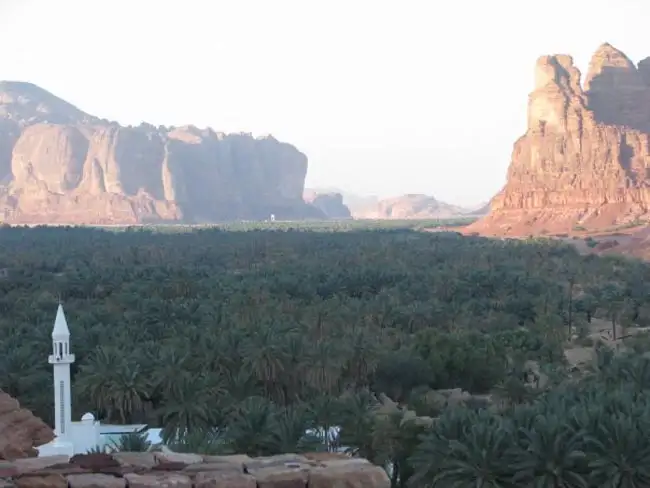
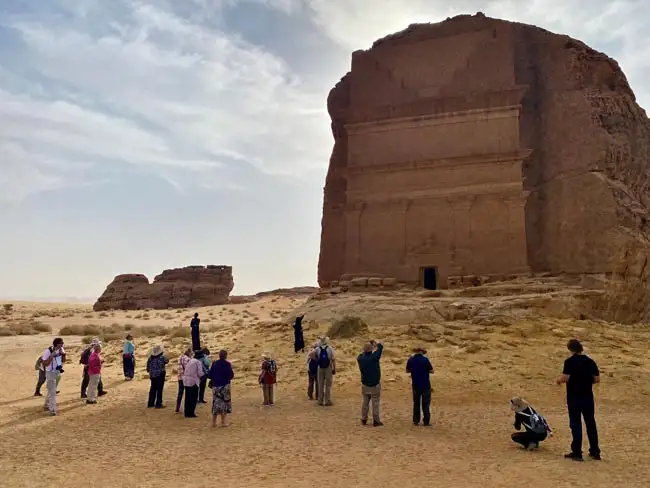
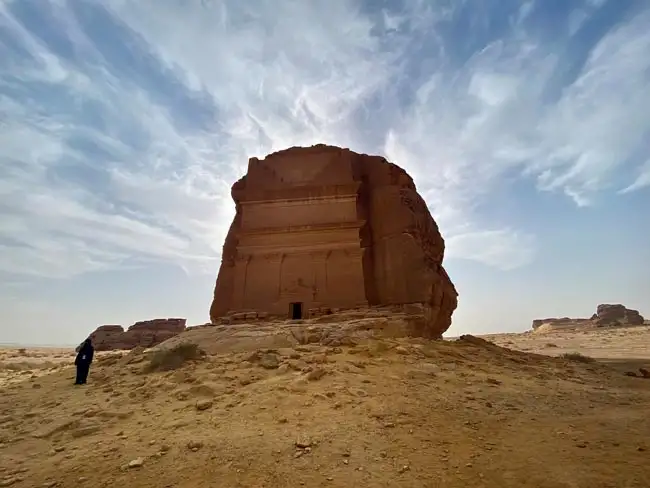
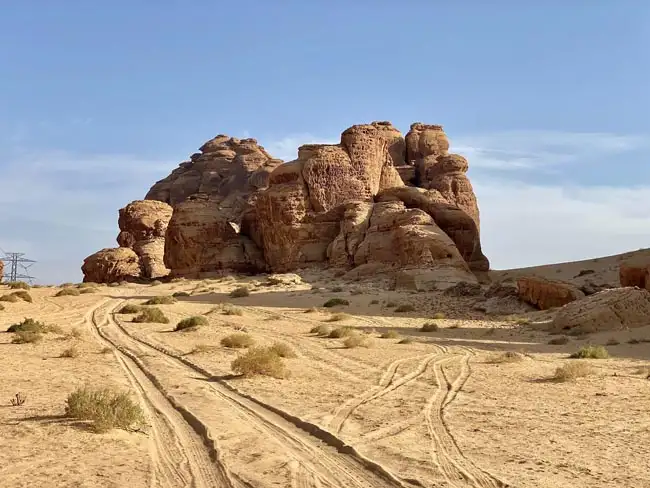
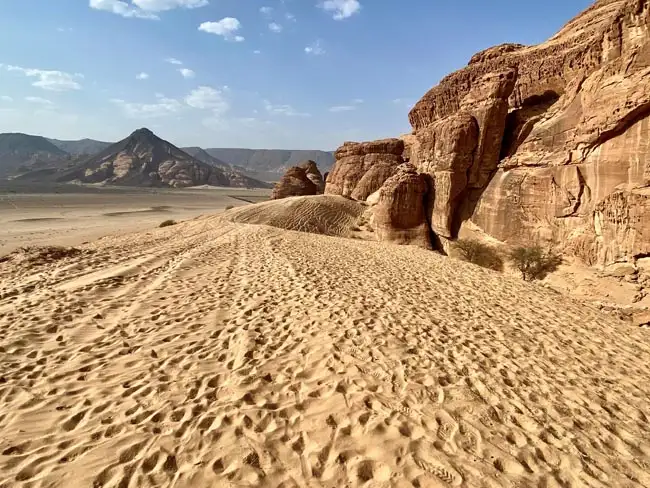
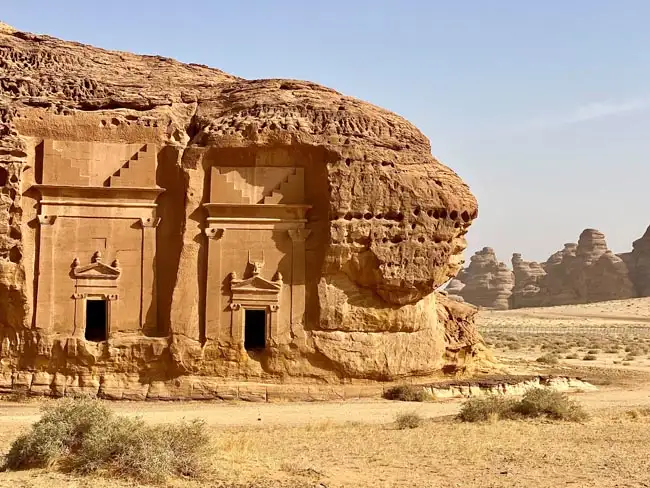
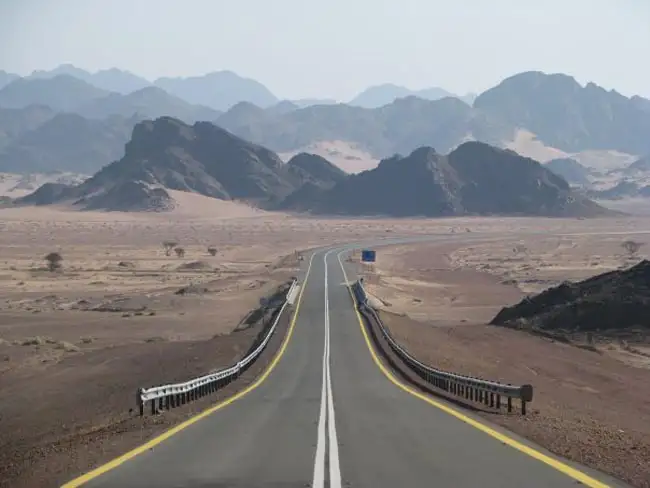
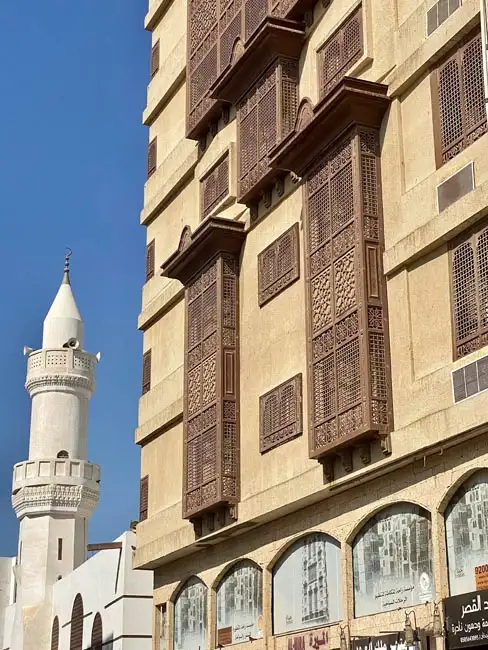
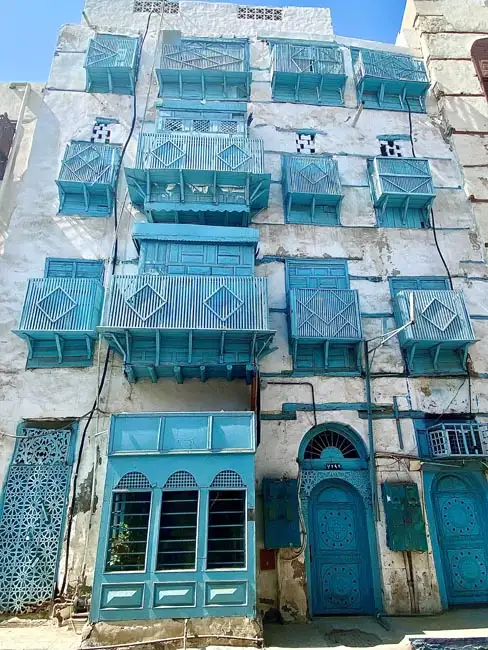
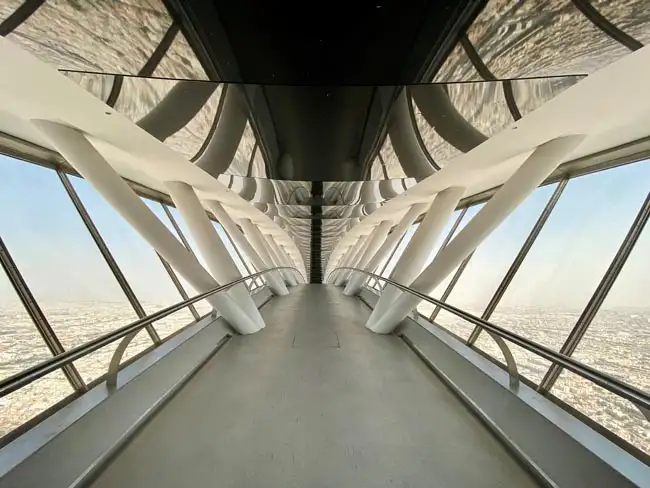
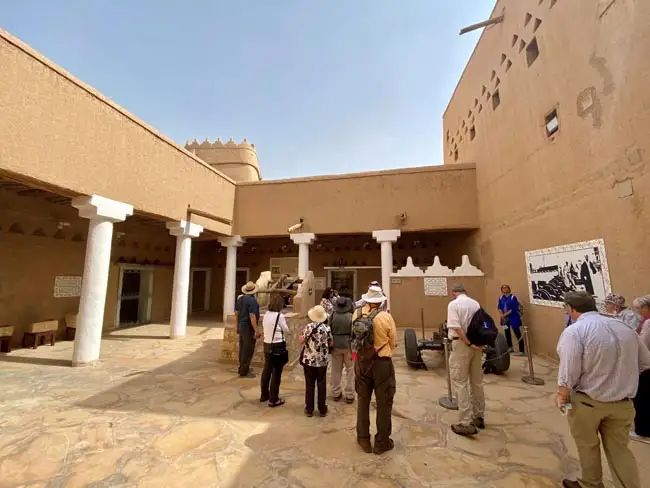
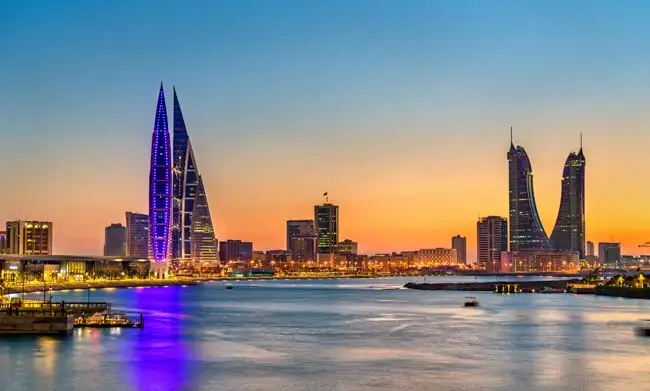
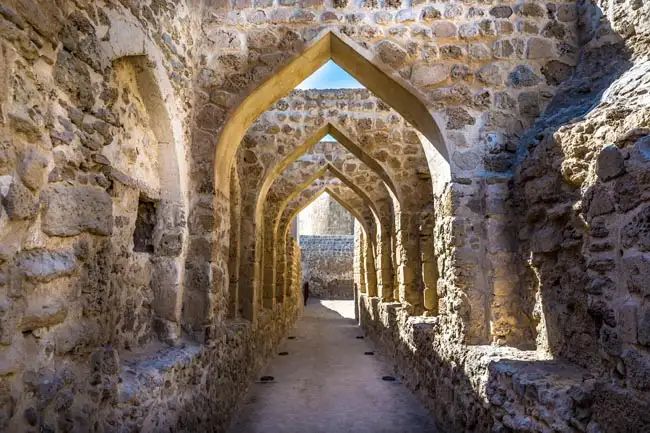
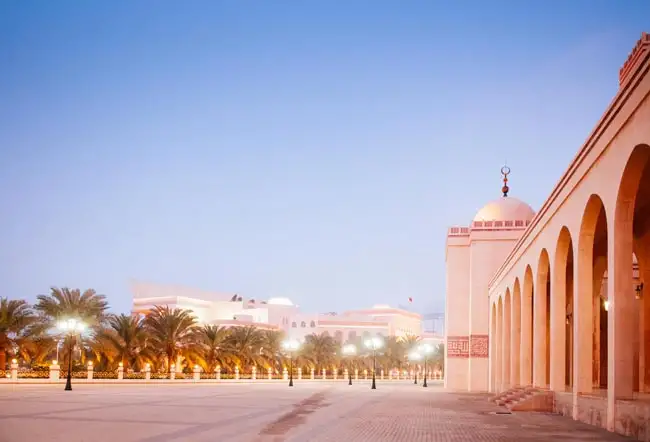
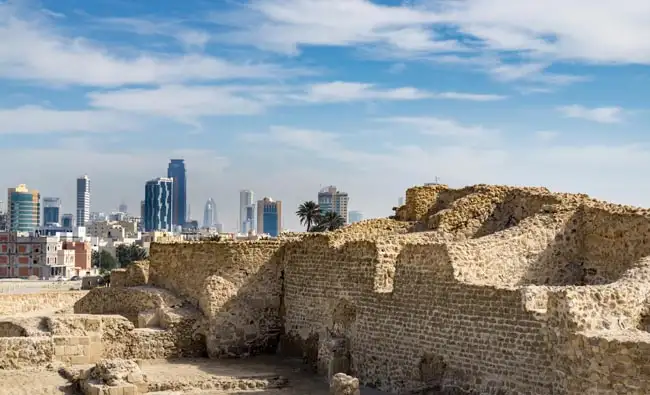
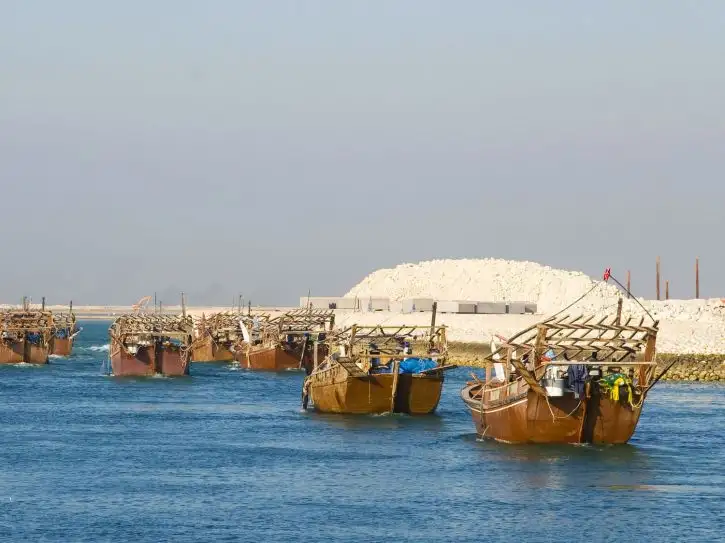
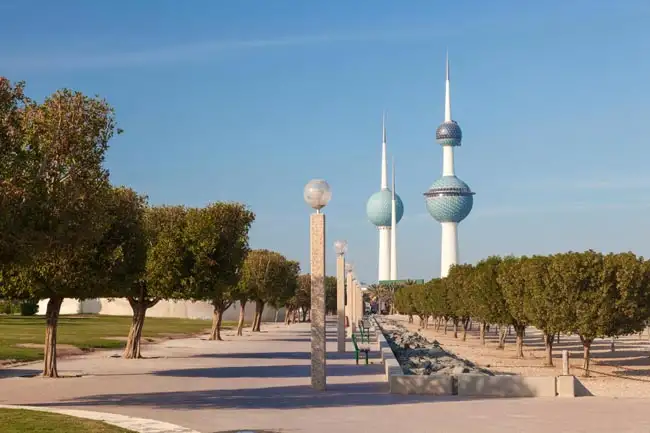
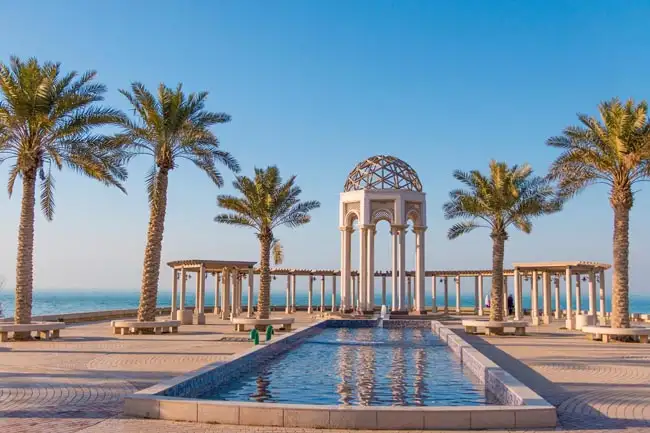
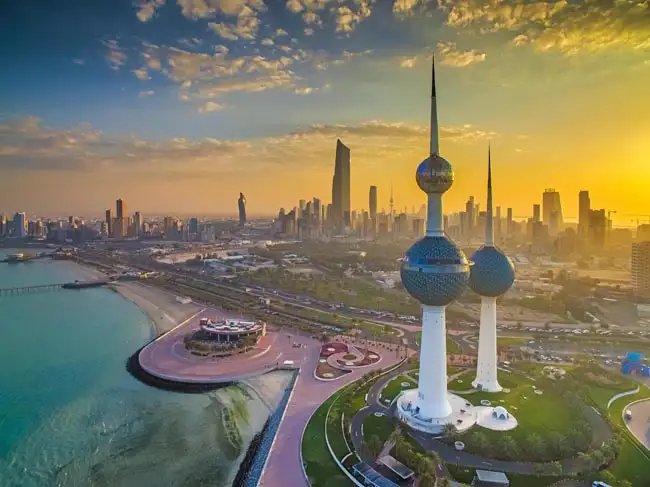
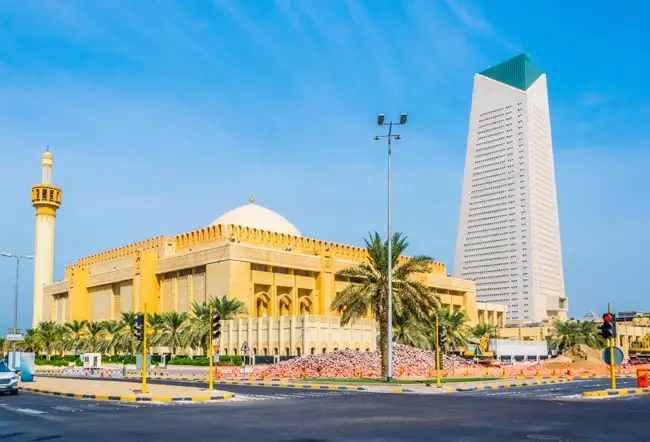

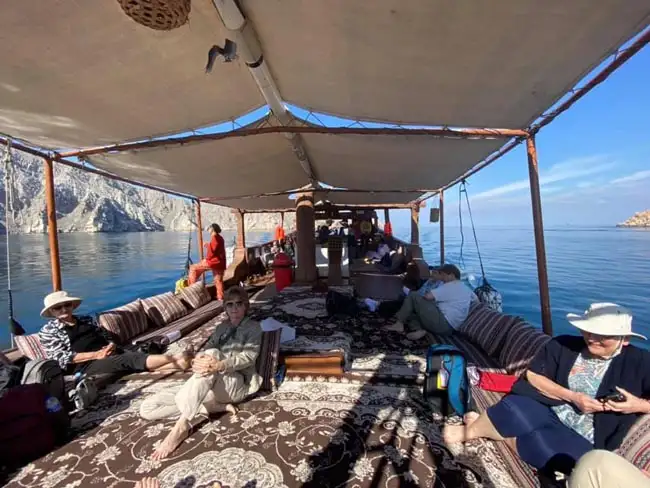
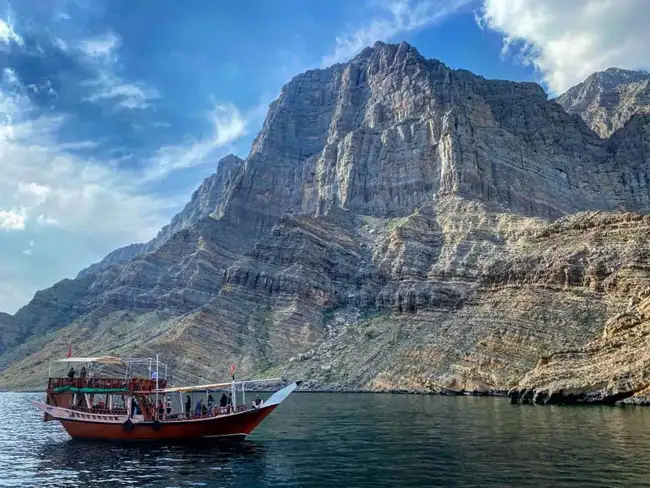
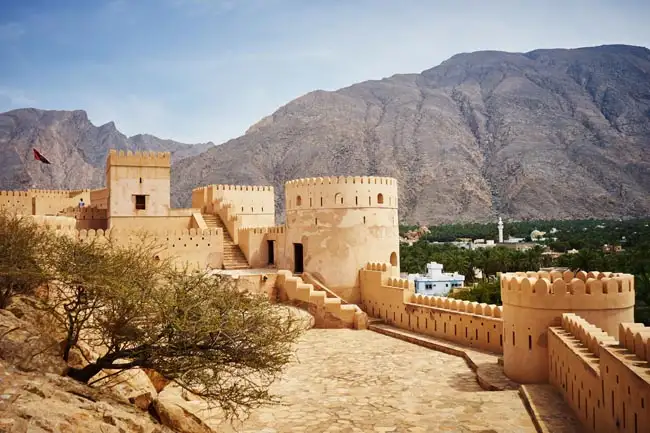
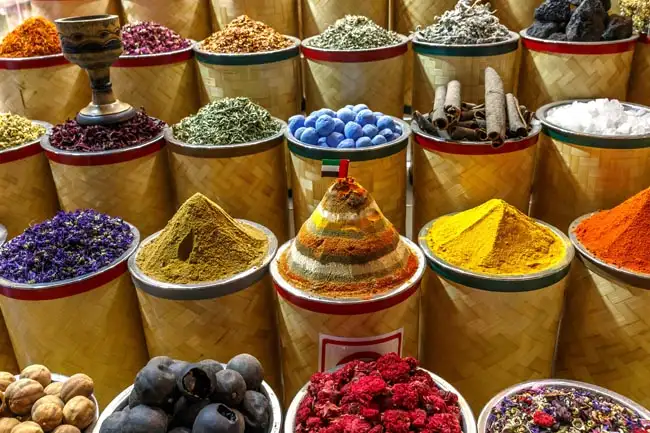
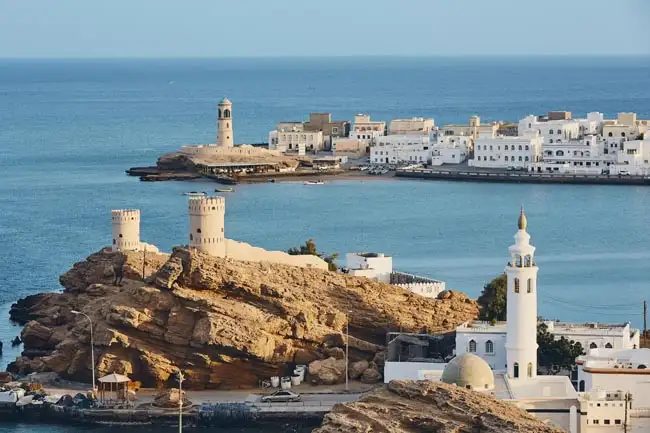
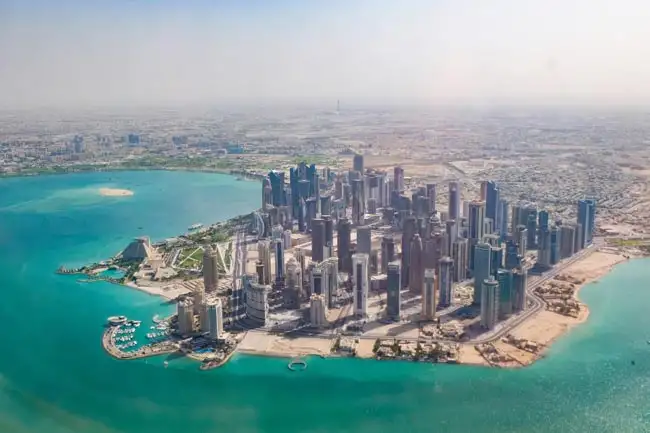
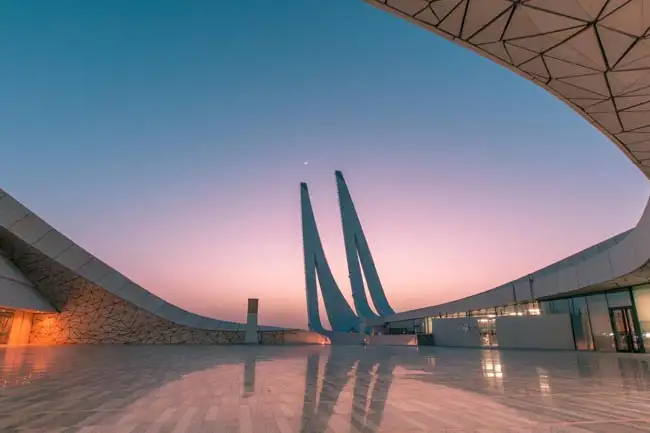
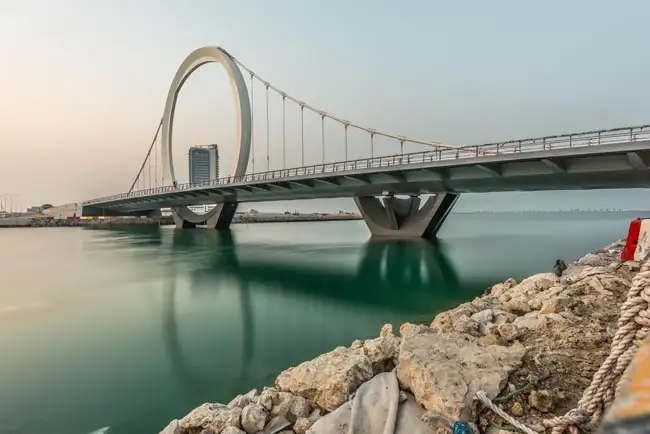
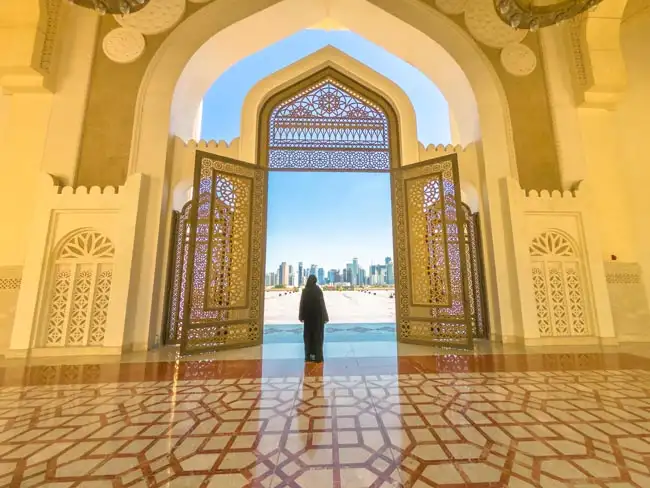
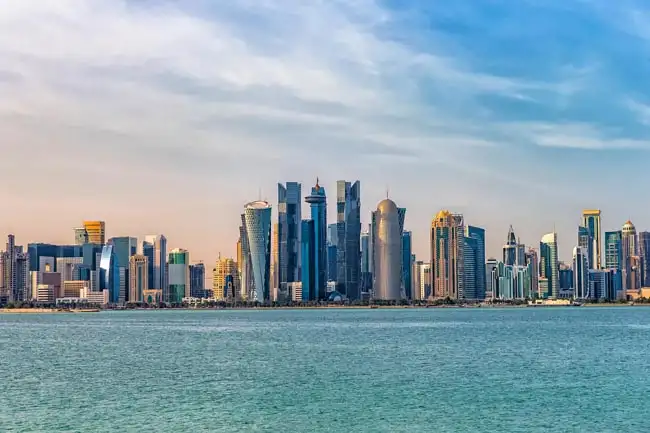
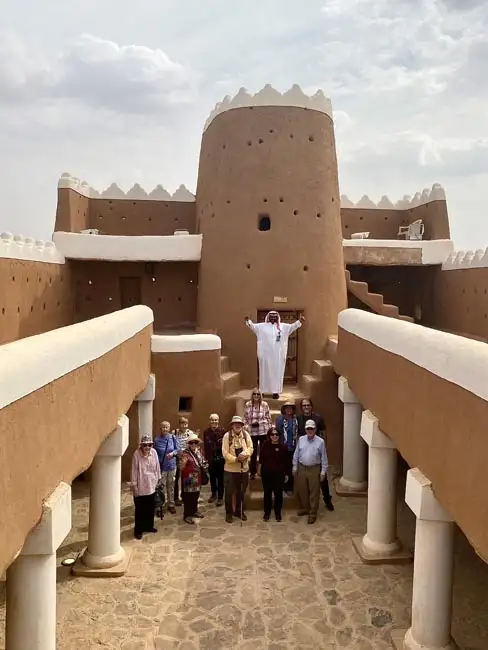
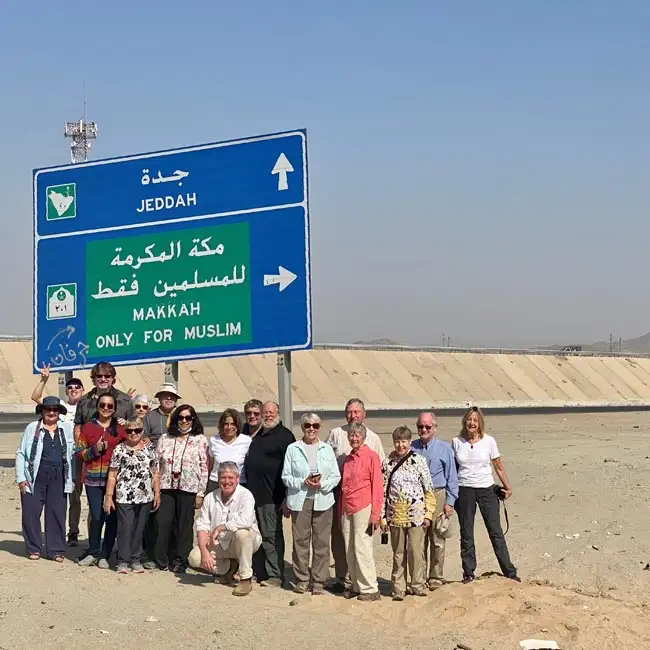
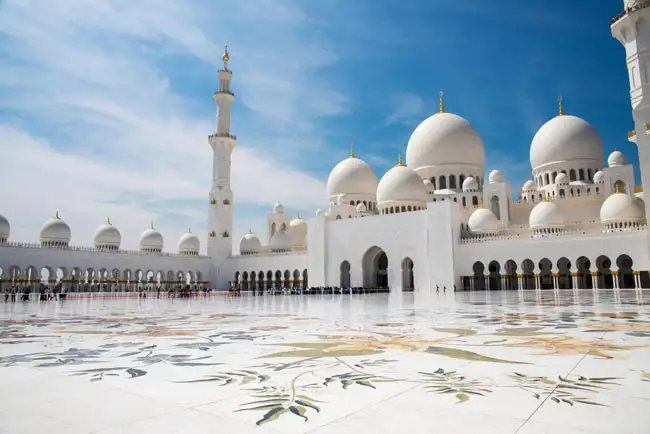
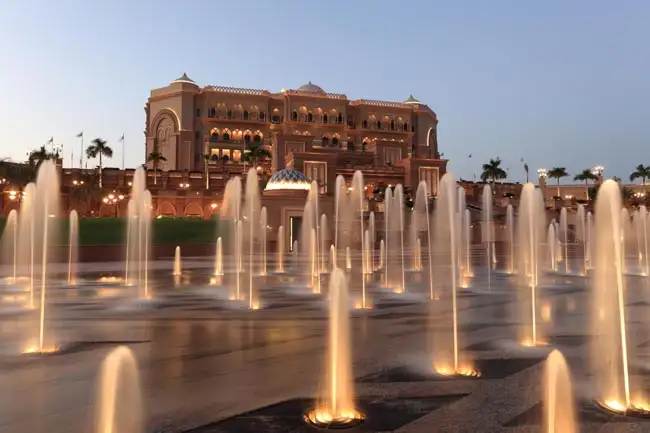
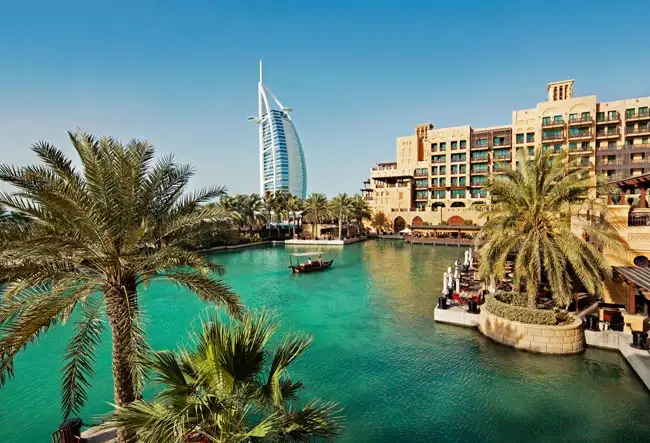
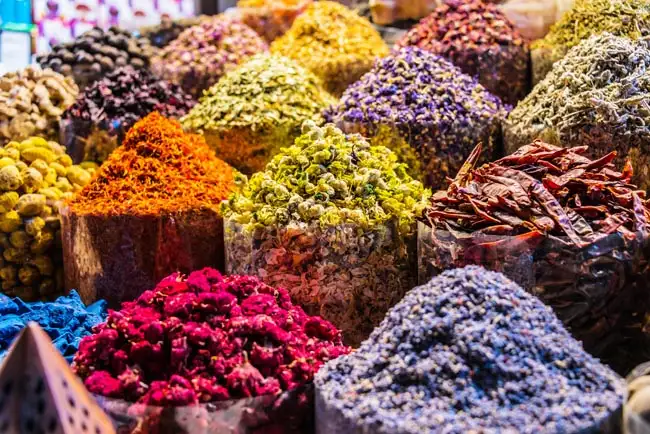
Excellent
Overall Rating
4.6
Extend Your Trip
This tour is part of a series that can be upgraded to make for a longer trip.
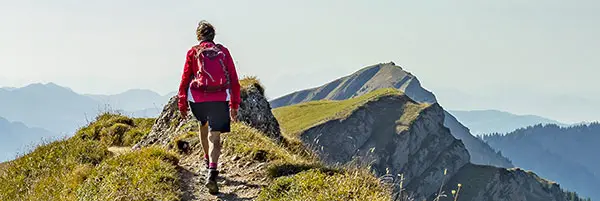
Fast and easy
Book this tour
Book your unforgettable adventure today! For any questions or advice, don't hesitate to contact us.
Have questions?
Contact Us
1-800-665-3998
- Final payment is due 90 days prior to departure.
- A non-refundable $1000 USD deposit is payable at the time of booking
- Optional Single Supplement: $3380 USD (number of singles limited).
This tour may require a mandatory single supplement charge of $2540 USD if you join our share program and we are unable to pair you. - Transferring to another tour or tour date is only permissible outside of 120 days prior to departure and is subject to a $100 USD change fee. (Read our cancellation policy for more info.)
- Entry/VISA requirements for one or more of the countries visited require that your passport not show any evidence of a prior visit to Israel.
Prices below are per person, twin-sharing costs in US Dollars (USD). Pricing does not include airfare to/from the tour and any applicable taxes. Get general information on flights to/from the tour.
Choose your departure date:
Frequently Asked Questions
- What is the maximum number of participants on a trip?Most of our tours carry a maximum of 18 participants; some tours (ie hiking tours) top out at 16. In the event that we do not achieve our minimum complement by our 90-day deadline, we may offer group members the option of paying a "small-group surcharge" as an alternative to cancellation. If all group members agree, we will confirm the trip at existing numbers; this surcharge is refundable in the event that we ultimately achieve our regular minimum. If the small group surcharge is not accepted, we will offer a refund of your deposit or a different trip of your choice.
- Can I extend my tour either at the beginning or end? What about stopovers?Yes, you can extend your tour either at the beginning or the end and we can book accommodation in our tour hotel. Stopovers are often permitted, depending on air routing. Stopovers usually carry a "stopover" fee levied by the airline.
- How do I make a reservation? How and when do I pay?The easiest way to make a reservation is via our website; during office hours, you are also more than welcome to contact us by telephone.
A non-refundable deposit is payable at the time of booking; if a reservation is made within 90 days, full payment is required. Some trips require a larger deposit. If international airline bookings require a non-refundable payment in order to secure space or the lowest available fare, we will require an increase in deposit equal to the cost of the ticket(s).
Early enrolment is always encouraged as group size is limited and some trips require greater preparation time.
Once we have received your deposit, we will confirm your space and send you a confirmation package containing your trip itinerary, any visa/travel permit related documents, invoice, clothing and equipment recommendations, general information on your destination(s), and forms for you to complete, sign and return to us. Your air e-tickets (if applicable), final hotel list, final trip itinerary, and instructions on how to join your tour, will be sent approximately 2-3 weeks prior to departure. - What about cancellations, refunds, and transfers?Please review our cancellation policy page for details.
- I am a single who prefers my own room. What is a single supplement?All of our tours have a single supplement for those who want to be guaranteed their own room at each location.
This supplement is a reflection of the fact that most hotels around the world do not discount the regular twin-share rate for a room by 50% for only one person occupying a room. Most hotels will give a break on the price, but usually in the range of 25-30% of the twin-share rate. This difference, multiplied by each night, amounts to the single supplement.
The conventional amount can also vary from country to country and some destinations are more expensive than others for single occupancy. In order to be "single friendly," the supplements we apply are not a profit centre for us and we do our best to keep them as reasonable as possible.
On most tours we limit the number of singles available, not to be punitive, but rather because many hotels allow for only a limited number of singles; some smaller hotels at remote locations also have a limited number of single rooms available.
Please note that most single rooms around the world are smaller than twin-share rooms and will likely have only one bed. - Do you have a shared accommodation program?Yes! If you are single traveller and are willing to share, we will do our best to pair you with a same-gender roommate. On most of our tours, if we fail to pair you, we will absorb the single supplement fee and you will default to a single room at no extra charge. At some destinations, however, where single rooms are not significantly discounted, or not at all, we may apply a "mandatory" single in the event that we cannot find you a share partner. This is usually 50% of the usual supplement, but can be as much as 100%. If applicable, this proviso will be noted on each tour page on this website, on your invoice, and in our tour date/price book (available for download under "Resources").
Please choose a departure date!
